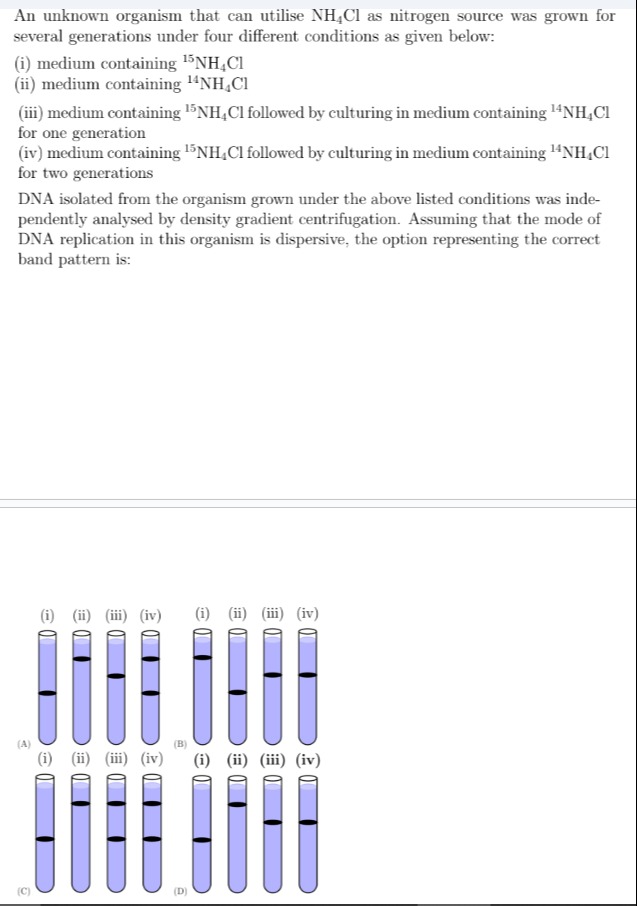Question
Question: An unknown organism that can utilise $NH_4Cl$ as nitrogen source was grown for several generations u...
An unknown organism that can utilise NH4Cl as nitrogen source was grown for several generations under four different conditions as given below:
(i) medium containing 15NH4Cl (ii) medium containing 14NH4Cl (iii) medium containing 15NH4Cl followed by culturing in medium containing 14NH4Cl for one generation (iv) medium containing 15NH4Cl followed by culturing in medium containing 14NH4Cl for two generations
DNA isolated from the organism grown under the above listed conditions was independently analysed by density gradient centrifugation. Assuming that the mode of DNA replication in this organism is dispersive, the option representing the correct band pattern is:

(A)
(B)
(C)
(D)
A
Solution
The question asks to identify the correct band pattern for DNA isolated from an organism undergoing dispersive DNA replication under four different conditions, analyzed by density gradient centrifugation.
Let's analyze each condition based on the principle of dispersive DNA replication:
In dispersive replication, the parental DNA molecule is broken into fragments, and new DNA is synthesized in short stretches. These fragments then reassemble, resulting in daughter DNA molecules that contain a mixture of parental and newly synthesized DNA in each strand. This means that after one round of replication, all DNA molecules will have an intermediate density. In subsequent generations in a lighter medium, the proportion of lighter isotope will increase, making the DNA progressively lighter, but still maintaining a mixed (intermediate) nature, resulting in a single band that shifts towards the lighter density.
Let's denote DNA containing only 15N as 'Heavy' (H), and DNA containing only 14N as 'Light' (L). DNA containing a mixture of 15N and 14N will be 'Intermediate' (I). In density gradient centrifugation, Heavy DNA forms a band at the bottom, Light DNA at the top, and Intermediate DNA in the middle.
- Condition (i): medium containing 15NH4Cl
The organism is grown for several generations in a medium containing 15NH4Cl. All the nitrogen available for DNA synthesis is 15N. Therefore, the DNA will be entirely heavy (15N−15N).
- Band pattern: A single band at the bottom of the tube (heavy density).
- Condition (ii): medium containing 14NH4Cl
The organism is grown for several generations in a medium containing 14NH4Cl. All the nitrogen available for DNA synthesis is 14N. Therefore, the DNA will be entirely light (14N−14N).
- Band pattern: A single band at the top of the tube (light density).
- Condition (iii): medium containing 15NH4Cl followed by culturing in medium containing 14NH4Cl for one generation
- Initially, all DNA is heavy (15N−15N) from growth in 15NH4Cl.
- After one generation in 14NH4Cl, due to dispersive replication, the parental 15N DNA fragments are mixed with newly synthesized 14N fragments. All resulting DNA molecules will be a mosaic of 15N and 14N.
- Band pattern: A single band at the intermediate position (middle) of the tube.
- Condition (iv): medium containing 15NH4Cl followed by culturing in medium containing 14NH4Cl for two generations
- After the first generation in 14NH4Cl (as in condition iii), all DNA is of intermediate density, containing a mixture of 15N and 14N.
- When this intermediate DNA replicates for a second generation in 14NH4Cl, the existing DNA fragments (which are already a mix of 15N and 14N) will be dispersed and mixed with newly synthesized 14N fragments.
- The resulting DNA molecules will still be a mosaic of 15N and 14N, thus forming a single intermediate band. However, the proportion of 14N will have increased compared to the first generation in 14N, making the DNA slightly lighter.
- Band pattern: A single band at an intermediate position, but slightly higher (closer to the light band) than the band in condition (iii).
Now, let's evaluate the given options based on these predictions:
-
Option (A):
- (i) Shows a heavy band (bottom). Correct.
- (ii) Shows a light band (top). Correct.
- (iii) Shows an intermediate band (middle). Correct.
- (iv) Shows an intermediate band, slightly higher than (iii)'s band. Correct.
This option perfectly matches the predicted pattern for dispersive replication.
-
Option (B): (iv) shows the band at the same position as (iii), which is incorrect for dispersive replication as the density should shift towards lighter with more generations in 14N.
-
Option (C): (iii) and (iv) show two bands (heavy and light), which is characteristic of conservative replication, not dispersive.
-
Option (D): (iii) shows an intermediate band, but (iv) shows two bands (intermediate and light), which is characteristic of semi-conservative replication after two generations, not dispersive.
Therefore, Option (A) correctly represents the band pattern for dispersive DNA replication.
